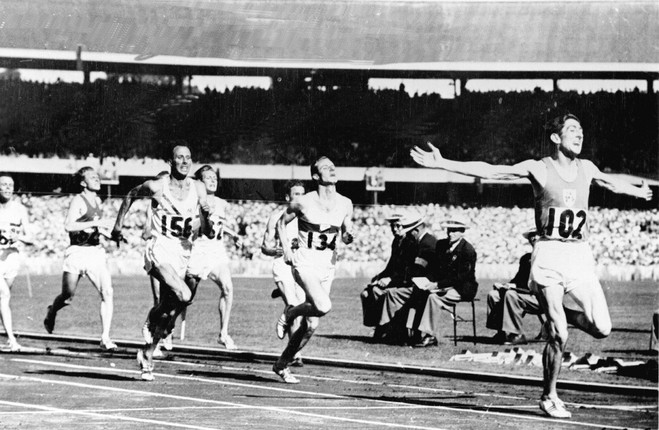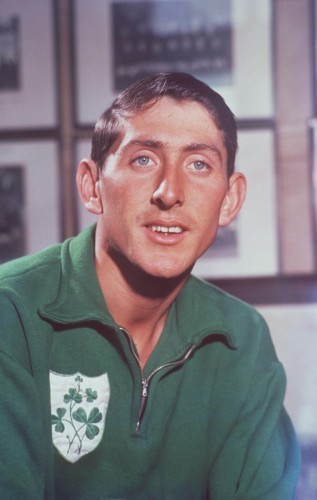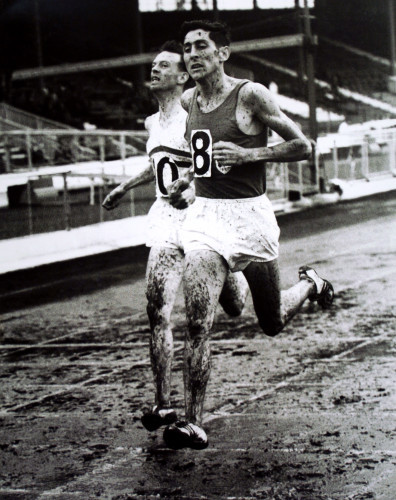RONNIE DELANY IS the fourth subject in our series of articles focusing on the most important Irish sportspeople of the last 100 years. The list will include GAA players, Olympians, boxers, golfers and more who dared to dream.
While Delany was famously coached by Jumbo Elliott — a man who produced 28 Olympians and five gold medallists — at Villanova University, it was during a training session with Brutus Hamilton in November 1956 that the young Irish athlete first felt his dream of Olympic gold could become a reality.
As Delany was making his way back to the dressing rooms after a particularly arduous work out, Hamilton tapped him on the shoulder and said they’d forgotten something.
“We then walked back down the track where he produced a piece of string from his pocket and told me to tie it to two poles on either side of the running surface,” Delany later recalled.
“I was then instructed to go back and run through the tape with my arms outstretched. At that point he shouted across to me, ‘now we’ve practised everything for Melbourne.’”
How right he was.
Ronald Delany’s story starts 21 years earlier when he was born in Wicklow on 6 March 1935 before moving to Dublin at the age of six. As with many of his peers, he dabbled in numerous sports but it was not until his teenage years that he settled on athletics.
By the age of 18 he realised he might have something special when he broke two minutes for the half mile in one of his first senior races.
Though he gained admission to the Irish Army’s Cadet College after secondary school, Delany passed up on both that and the opportunity to attend university in Ireland, instead opting to travel to the US to study economics at Villanova University on the advice of Fred Dwyer, a former miler who would go on to become a world-renowned coach.
Delany arrived in Pennsylvania as an 800m runner but the first time Elliott saw him on the track he knew that the mile would be the perfect distance for his new charge. In 1955, the coach sent Delany home to Dublin for the summer where he raced over that distance and, on wet grass, clocked 4:05.
On his return to Villanova, the real training began.
Preparation for the 1956 games was not always smooth. In a race meet in May that year, Delany — renowned for his finishing speed — decided to take on the man many regarded as the finest miler in the world, John Landy, from the gun.
By halfway, Delany’s race was already run and he trailed home more than 50 metres behind the Australian.
He bounced back though and in some style. At the prestigious Compton Invitation meeting in June 1956, he beat Denmark’s Gunnar Neilsen — the world record holder — on the line and his time of 3.59.1 made him the youngest of the seven members of the sub-four minute mile club.
If Delany thought that result meant selection for the Irish Olympic team was a foregone conclusion, he could not have been more wrong, however. Coming back from a ‘spiking’ at a race in Paris too quickly, Delany ran his slowest ever mile time of 4.20 in Dublin and it was only on the casting vote of Lord Killanin, the president of the Olympic Council of Ireland, that he was selected at all.
After some trouble with lost travel documents that required a local postmaster to take the unusual step of opening on a Saturday, Delany eventually joined up with the 17 other members of the Irish Olympic team for the trip to Australia.
Given that this would be the first Games since Roger Bannister’s inaugural sub-four minute mile, the 1500m was the must-see event of the Melbourne Olympics and included five of the seven men in the world to break that barrier, one that many had described as impenetrable.
Delany’s qualifying heat would prove to be a lot easier than his selection, taking third spot with little difficulty and making the final two days later.
In the final, as Murray Halberg of New Zealand and Australia’s Merv Lincon took the early pace, Delany settled at the back of the field, biding his time. Remarkably, at the bell, just five metres covered the entire field but Delany took the decision to move out wide to cover any possible break.
The first to take his shot at gold was home-favourite Landy but Delany moved comfortably into his slip-stream. Thrusting his kick, the 21-year-old eased past Landy with 150 meters to go and breasted the line running away from the field in an Olympic record of 3:41.2 before falling to his knees in prayer.
Two years later, in 1958, he became the first Irishman to win a medal in the European Championships in the 1500m in Stockholm and between 1956 and 1959 he won 40 indoor races in a row, including 33 mile events, before injury brought an end to his career in 1962.
In retirement, Delany became a very successful business man and ambassador for Irish athletics but it was for his performance in Melbourne, against the very best the world had to offer, that he was awarded the Freedom of the City of Dublin in 2006.
Almost 60 years after he crossed the finish line in Australia, arms outstretched the way Brutus Hamilton had shown him, Delany’s remains Ireland’s last track and field Olympic gold medal.
Over the next four months, in association with Allianz Insurance, we’ll be profiling the 16 most important Irish athletes of the last 100 years.
Allianz Insurance — The world belongs to those who dare.




